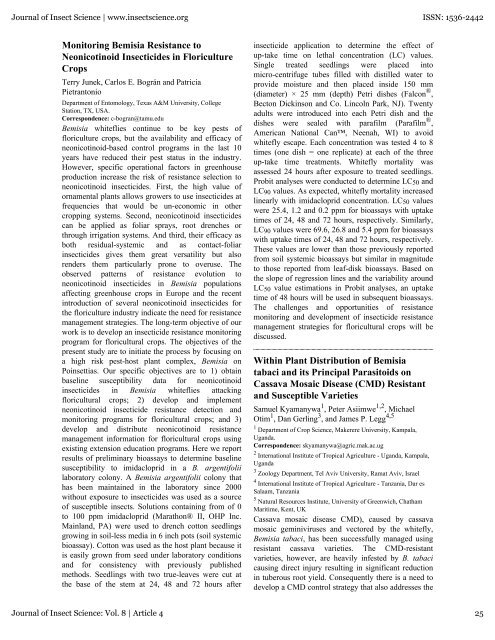Fourth International Bemisia Workshop International Whitefly ...
Fourth International Bemisia Workshop International Whitefly ...
Fourth International Bemisia Workshop International Whitefly ...
Create successful ePaper yourself
Turn your PDF publications into a flip-book with our unique Google optimized e-Paper software.
Journal of Insect Science | www.insectscience.org ISSN: 1536-2442<br />
Monitoring <strong>Bemisia</strong> Resistance to<br />
Neonicotinoid Insecticides in Floriculture<br />
Crops<br />
Terry Junek, Carlos E. Bográn and Patricia<br />
Pietrantonio<br />
Department of Entomology, Texas A&M University, College<br />
Station, TX, USA.<br />
Correspondence: c-bogran@tamu.edu<br />
<strong>Bemisia</strong> whiteflies continue to be key pests of<br />
floriculture crops, but the availability and efficacy of<br />
neonicotinoid-based control programs in the last 10<br />
years have reduced their pest status in the industry.<br />
However, specific operational factors in greenhouse<br />
production increase the risk of resistance selection to<br />
neonicotinoid insecticides. First, the high value of<br />
ornamental plants allows growers to use insecticides at<br />
frequencies that would be un-economic in other<br />
cropping systems. Second, neonicotinoid insecticides<br />
can be applied as foliar sprays, root drenches or<br />
through irrigation systems. And third, their efficacy as<br />
both residual-systemic and as contact-foliar<br />
insecticides gives them great versatility but also<br />
renders them particularly prone to overuse. The<br />
observed patterns of resistance evolution to<br />
neonicotinoid insecticides in <strong>Bemisia</strong> populations<br />
affecting greenhouse crops in Europe and the recent<br />
introduction of several neonicotinoid insecticides for<br />
the floriculture industry indicate the need for resistance<br />
management strategies. The long-term objective of our<br />
work is to develop an insecticide resistance monitoring<br />
program for floricultural crops. The objectives of the<br />
present study are to initiate the process by focusing on<br />
a high risk pest-host plant complex, <strong>Bemisia</strong> on<br />
Poinsettias. Our specific objectives are to 1) obtain<br />
baseline susceptibility data for neonicotinoid<br />
insecticides in <strong>Bemisia</strong> whiteflies attacking<br />
floricultural crops; 2) develop and implement<br />
neonicotinoid insecticide resistance detection and<br />
monitoring programs for floricultural crops; and 3)<br />
develop and distribute neonicotinoid resistance<br />
management information for floricultural crops using<br />
existing extension education programs. Here we report<br />
results of preliminary bioassays to determine baseline<br />
susceptibility to imidacloprid in a B. argentifolii<br />
laboratory colony. A <strong>Bemisia</strong> argentifolii colony that<br />
has been maintained in the laboratory since 2000<br />
without exposure to insecticides was used as a source<br />
of susceptible insects. Solutions containing from of 0<br />
to 100 ppm imidacloprid (Marathon® II, OHP Inc.<br />
Mainland, PA) were used to drench cotton seedlings<br />
growing in soil-less media in 6 inch pots (soil systemic<br />
bioassay). Cotton was used as the host plant because it<br />
is easily grown from seed under laboratory conditions<br />
and for consistency with previously published<br />
methods. Seedlings with two true-leaves were cut at<br />
the base of the stem at 24, 48 and 72 hours after<br />
insecticide application to determine the effect of<br />
up-take time on lethal concentration (LC) values.<br />
Single treated seedlings were placed into<br />
micro-centrifuge tubes filled with distilled water to<br />
provide moisture and then placed inside 150 mm<br />
(diameter) × 25 mm (depth) Petri dishes (Falcon ® ,<br />
Becton Dickinson and Co. Lincoln Park, NJ). Twenty<br />
adults were introduced into each Petri dish and the<br />
dishes were sealed with parafilm (Parafilm ® ,<br />
American National Can, Neenah, WI) to avoid<br />
whitefly escape. Each concentration was tested 4 to 8<br />
times (one dish = one replicate) at each of the three<br />
up-take time treatments. <strong>Whitefly</strong> mortality was<br />
assessed 24 hours after exposure to treated seedlings.<br />
Probit analyses were conducted to determine LC 50 and<br />
LC 90 values. As expected, whitefly mortality increased<br />
linearly with imidacloprid concentration. LC 50 values<br />
were 25.4, 1.2 and 0.2 ppm for bioassays with uptake<br />
times of 24, 48 and 72 hours, respectively. Similarly,<br />
LC 90 values were 69.6, 26.8 and 5.4 ppm for bioassays<br />
with uptake times of 24, 48 and 72 hours, respectively.<br />
These values are lower than those previously reported<br />
from soil systemic bioassays but similar in magnitude<br />
to those reported from leaf-disk bioassays. Based on<br />
the slope of regression lines and the variability around<br />
LC 50 value estimations in Probit analyses, an uptake<br />
time of 48 hours will be used in subsequent bioassays.<br />
The challenges and opportunities of resistance<br />
monitoring and development of insecticide resistance<br />
management strategies for floricultural crops will be<br />
discussed.<br />
Within Plant Distribution of <strong>Bemisia</strong><br />
tabaci and its Principal Parasitoids on<br />
Cassava Mosaic Disease (CMD) Resistant<br />
and Susceptible Varieties<br />
Samuel Kyamanywa 1 , Peter Asiimwe 1,2 , Michael<br />
Otim 1 , Dan Gerling 3 , and James P. Legg 4,5<br />
1 Department of Crop Science, Makerere University, Kampala,<br />
Uganda.<br />
Correspondence: skyamanywa@agric.mak.ac.ug<br />
2 <strong>International</strong> Institute of Tropical Agriculture - Uganda, Kampala,<br />
Uganda<br />
3 Zoology Department, Tel Aviv University, Ramat Aviv, Israel<br />
4 <strong>International</strong> Institute of Tropical Agriculture - Tanzania, Dar es<br />
Salaam, Tanzania<br />
5 Natural Resources Institute, University of Greenwich, Chatham<br />
Maritime, Kent, UK<br />
Cassava mosaic disease CMD), caused by cassava<br />
mosaic geminiviruses and vectored by the whitefly,<br />
<strong>Bemisia</strong> tabaci, has been successfully managed using<br />
resistant cassava varieties. The CMD-resistant<br />
varieties, however, are heavily infested by B. tabaci<br />
causing direct injury resulting in significant reduction<br />
in tuberous root yield. Consequently there is a need to<br />
develop a CMD control strategy that also addresses the<br />
Journal of Insect Science: Vol. 8 | Article 4 25
















